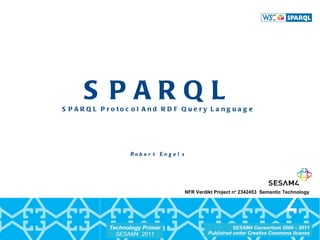
Sesam4 project presentation sparql - april 2011
- 1. SPARQL SPARQL Protocol And RDF Query Language Robert Engels NFR Verdikt Project n o 2342453 Semantic Technology
- 2. from local to global Information management in the digital age From Locally isolated ... ... to Globally interconnected
- 3. But What CAN you get out of this?
- 8. SPARQL - “DESCRIBE” Suppose The only thing you have is an Uri like this And no idea what is known about it.... http://data.esis.no/resource/projectID_111667 Simply send a SPARQL “DESCRIBE” to a sparql endpoint DESCRIBE <http://data.esis.no/resource/projectID_111667>
- 9. Result of SPARQL - “DESCRIBE” “ DESCRIBE” This node for me:
- 10. Result of SPARQL - “DESCRIBE” 1 1 1 1 1 2 2
- 11. SPARQL - “SElect” ... or you know what to look for and want to select specific resources. Send a sparql “select” to a sparql endpoint PREFIX rdf: <http://www.w3.org/1999/02/22-rdf-syntax-ns#> PREFIX dct: <http://purl.org/dc/terms/> PREFIX nfr: <http://data.esis.no/resource/> PREFIX foaf: <http://xmlns.com/foaf/0.1/> SELECT ?projectID ?projectName WHERE { ?projectID a foaf:Project ; dct:title ?projectName ; nfr:orgnrResponsibleOrg <https://ws.brreg.no/lod/enhet/962392687> . }
- 13. RESULT SPARQL - “SELECT”
- 14. SPARQL - “CONSTRUCT” REPLACE NEW PREFIX rdf: <http://www.w3.org/1999/02/22-rdf-syntax-ns#> PREFIX dct: <http://purl.org/dc/terms/> PREFIX nfr: <http://data.esis.no/resource/> PREFIX foaf: <http://xmlns.com/foaf/0.1/> PREFIX funder: <http://research.data.gov.uk/def/project/> CONSTRUCT { ?projectID funder:title ?title } WHERE { ?projectID a foaf:Project; dct:title ?title ; nfr:orgnrResponsibleOrg <https://ws.brreg.no/lod/enhet/962392687> . }
- 15. SPARQL - “ASK” TRUE or FALSE? PREFIX nfr: <http://data.esis.no/resource/> ASK { ?projectID nfr:orgnrResponsibleOrg <https://ws.brreg.no/lod/enhet/962392687> }
- 16. Try it yourself! http://data.esis.no:2020/query.html http://opendata.computas.no:7001/joseki/
- 18. www.sesam4.net
Hinweis der Redaktion
- Retorics: - where before information was locally managed, using local keys, and only accessible through customised interfaces using these “local keys” to identify information … … today this very same information is available from many different sources, represented in a standard way using globally unique identifiers … .. which are connected to each other and in such a way provide explicit key-references between different data-sets which can be used for automated harvesting and discovery
- So now you think: - this is too large, too complex and too big. I cannot possible see how I can work with this and yes: I cannot see what is wrong with normal relational databases and SQL querying .. - well there is good and bad news. The good news is that it is indeed BIG, the bad news is that it is also complex and maybe even huge. … - But there is more good news: some smart people at W3C have found a way to let you use this graphs using a query language which is very similar to SQL, called SPARQL.